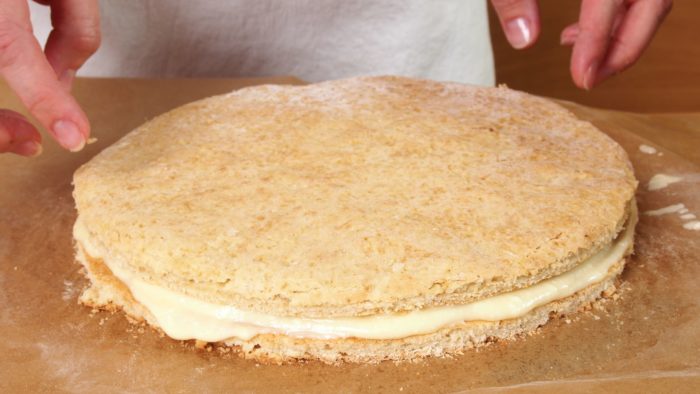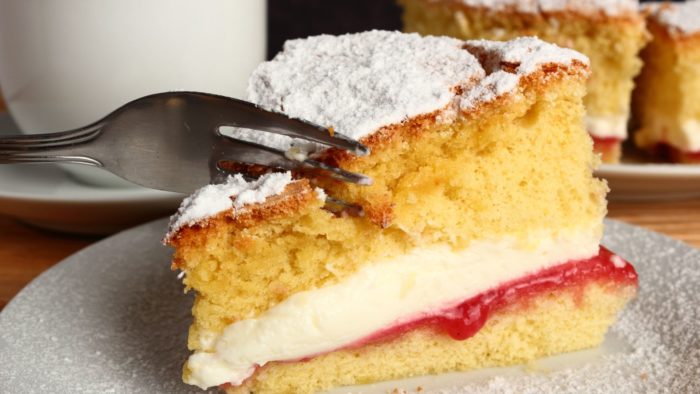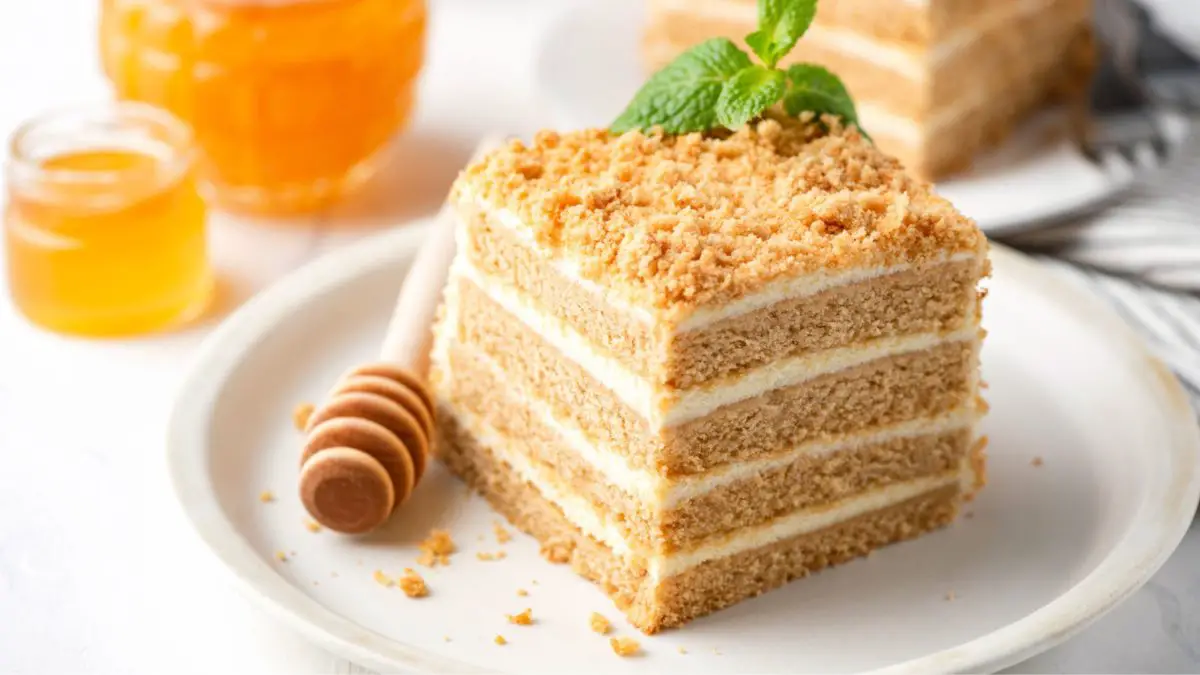Last Updated on December 29, 2022
If you’ve never used pudding between cake layers, thank us later! We’ll look at how to use instant pudding mixes and discuss mistakes to avoid!
This guide will help you explore the wonderful possibilities when it comes to using pudding between cake layers. These fillings will help you explore and expand your creativity and create some rave-worthy cakes in the process.
Can You Use Pudding Between Cake Layers?
You can easily put pudding between cake layers, but it isn’t as straightforward as you may be hoping for it to be. Usually, many different pudding products have different consistencies. And not all of them will be able to withstand even a little bit of weight from the cake layer above.
So, for that reason, most pudding-like fillings are made using instant pudding mixes blended with some structural or supporting ingredients.
These recipes either contain some type of whipped frosting (like whipped topping) or a stabilizing ingredient (like powdered sugar). Anything that can provide a more substantial consistency and a structure that can hold the cake. After all, you don’t want all of the filling oozing out of the sides, leaving the middle dry and bland!
So, what makes pudding between cake layers so great? Well, pudding fillings are creamy. And when we say creamy, expect the most creamy cake filling you have ever experienced in your life.
These pudding mixes are luscious, extremely flavorful, and have a voluptuous rich texture. And before we forget to mention, they are also super easy to make!

Pudding vs custard – What’s the difference?
Puddings and custards are very similar, but they aren’t always the same thing. A custard is made with thickened eggs and is more often than not vanilla flavored.
A pudding on the other hand is also a thick cream-based dessert, but it isn’t made with eggs and it can be flavored in many ways. Puddings are thickened with starch, which is why it is so easy to make powdered premixes.
Usually, when it comes to fillings, pudding-based fillings are made with powdered pudding pre-mixes.
Jell-O is arguably one of the most famous brands that produce this product. They have an extremely extensive range of flavors and even pudding types. This makes it super easy to match a product with the flavor of your cake.
Pudding vs cream fillings – How are they different?
While you may think cream equals creamy, that is not the case when it comes to fillings for cakes. Cream-based fillings are usually super soft and fluffy. But that’s about it. They often don’t have enough texture (or what we like to call, substance) to give you a lusciously creamy mouthfeel.
As we have mentioned, pudding fillings provide a rich, thick, and creamy consistency that pairs well with crumbly cakes.
What Type Of Pudding Works Best For Layering Cakes With?
By now you guys probably know we always say “homemade is best”. But, the day has come when we are going to contradict ourselves.
For pudding between cake layers, it is best to use an instant pudding mix instead. This is because these mixes contain a ton of stabilizers and thickening ingredients that will easily give you the perfect consistency for a filling. All that you need now is some structural support.
Furthermore, using an instant pudding mix will allow you to flavor the filling without “pudding” in any more effort – pun intended! But all jokes aside, you don’t have to buy any flavoring extracts and you don’t have to struggle to develop a balanced flavor. All of the work has already been done for you.
And finally, making pudding from scratch takes time, effort, and costs more money. The instant mixes are always very affordable and easy to work with.
How To Thicken Pudding Between Cake Layers
Now, as we have mentioned, pudding mixes do need some structural support to work as a filling between cake layers.
There are two types of recipes people like to make. The first is one with added whipped topping, and the second type is made with powdered sugar.
Whipping topping addition
These types of recipes are usually made with instant pudding mix, cold milk, and Cool Whip Whipped Topping.
First, the pudding mix is made and whisked together. The pudding will thicken on its own, but it shouldn’t be set inside the fridge.
Instead, once it is mixed, some thawed and whisked whipped topping is gently folded in. This gives the filling some structure so that it won’t simply melt into the cake or be pushed out of the sides.
Powdered sugar addition
The other method is more like a buttercream frosting that has been mixed with a pudding mix. You can of course just add powdered sugar to make the filling thicker, but many people like to add creamed butter for a fluffier texture.
Either way works, but just make sure that the recipes’ ratios work well. Otherwise, the pudding may just separate from the butter.

How Should You Store a Cake With Pudding Between The Layers?
Instant pudding mixes, when you make them as is, should always be kept inside the fridge. This is because they are made with milk and they need to remain solid. If they are kept at room temperature, they will soften more than they should and the milk will go rancid quickly.
The same applies when you use pudding between cake layers. If you don’t refrigerate the entire cake, the filling will ooze out and go rancid quickly. This in turn will cause the rest of the cake to also spoil more quickly.
So, always keep your cake with a pudding filling inside an airtight container. Then, store it in the fridge where its shelf life will be considerably extended!
How Long Does Pudding Cake Last in the Fridge?
Before you place the pudding cake in the fridge, it should first be cooled down. Once cooled, it’s best to cover it in plastic wrap and then it’ll last around 3 days in the refrigerator. Alternatively, you could place it in an airtight container and it will keep it in the freezer for around 6 months.
How Long Can a Cake With Pudding Sit Out?
As pudding is dairy and perishable, you need to ensure that you do not leave it out at room temperature for more than 3 hours or so. At this point, it’ll begin to spoil. Cakes containing pudding are always best kept in the refrigerator, covered in plastic wrap, for best results.
How to Make Vanilla Pudding Cake Filling?
I usually follow one of the following two vanilla pudding cake-filling recipes. Both are equally delicious and it’s worth mentioning that if you use either, the cakes should be refrigerated and not left at room temperature for more than two to three hours.
For the first recipe, you’ll need 1 packet of vanilla instant pudding mix, 1 1/2 cups of milk, and 1 1/2 – 2 cups of heavy whipping cream.
- Now all you need to do is mix the vanilla pudding with milk until smooth and then place it in the refrigerator for around 5 minutes.
- Remove from fridge and fold in the heavy whipping cream.
- Once folded in, you should have enough to fill a two-layer cake, as well as cover the top.
For the next recipe, you’ll need 2 cups of whipping cream, 2 tablespoons of powdered sugar, and 1 packet of instant vanilla pudding mix.
- Now all you need to do is add the whipping cream to a stand mixer and mix for a few minutes on high.
- Now gradually add the powdered sugar, along with the vanilla pudding mix.
- Keep mixing until you achieve a creamy and smooth texture.
Can You Use Cook and Serve Pudding in a Poke Cake?
Of course! It may be slightly more difficult to fill the holes with this type of pudding, but it’s definitely possible. To make a poke cake with cook-and-serve pudding, you’ll need the following ingredients: 1 box of yellow cake mix, 2 packets of chocolate cook & serve pudding, 1 cup of powdered sugar, 4 cups of milk, and 2 tablespoons of butter.
- Now all you need to do is follow the instructions on your boxed cake mix and bake as directed.
- Using the end of a wooden spoon, poke holes far down into your cake; around 1 inch apart.
- Grab a saucepan and add the pudding mixes, along with the sugar.
- Heat over medium heat and slowly add the milk and butter; stirring as you go.
- Bring to a boil and then remove from heat.
- Pour the pudding over your cake and place it in the refrigerator to set.
- Enjoy!
Can You Use Jello Pudding For Cake Filling?
Of course! Jello is one of the most popular brands of instant pudding and comes in a huge range of flavors. Jello pudding is perfect for cake filling and you can easily use it as the base of your cake filling.
In Conclusion
Hopefully, we took the fear out of using pudding between cake layers. This is a wonderful way to change up your cakes and incorporate new interesting flavors too.
If you would like to learn more baking tips and tricks, head to our site to look for other informative posts like these.
FAQs
Can you use pudding in between layers of the cake?
You can use pudding between the layers of your cakes. But, you will need to give it some structural support. Pudding mix on its own will either seep into the cake, melt away completely, or run out of the sides. By simply adding some powdered sugar, buttercream frosting, or whipped topping, you can help give it support so it remains in place.
How do you thicken pudding filling for a cake?
The best way to do this is to add whipped topping. This is easy and quick. But, you can also add buttercream frosting or some powdered sugar. Both will work well, even though they do take extra time.
What is the cream between cake layers called?
These creams are usually a type of custard, not a type of pudding mix. Custard fillings differ from pudding-based ones as they are made using eggs, not starch. But, today you get many other creamy pudding fillings for cakes too.
What happens when you add pudding to a cake mix?
Instant pudding mix will do a few things when added to a cake batter. It will add more flavor, a lot more moistness, and create an overall denser cake texture. Puddings themselves are pretty dense, so don't expect them to magically make fluffy cakes.

Lindy Van Schalkwyk is a culinary specialist with a background in Advanced Cooking, Advanced Pâtisserie, Media Communications and Nutrition. She has gained invaluable experience in the culinary industry having worked in some of the top restaurants in Africa in 2016 and 2017. Her expertise in nutrition has enabled her to develop recipes for special dietary needs. In 2018, Lindy began working in the Food Media industry, focusing on recipe development, recipe writing, food writing and food styling.


